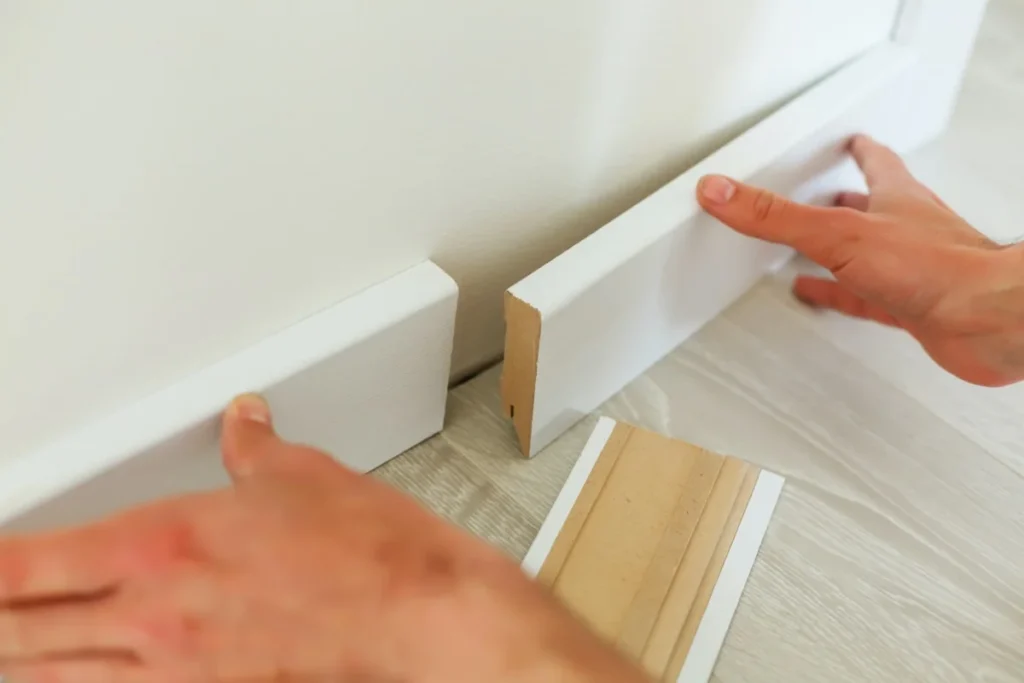Learning how to cut baseboard is a fundamental skill for any DIY enthusiast or professional carpenter. Baseboards add the finishing touch to a room and require precise cutting to ensure a perfect fit. In this guide, we will explore various trimming techniques to help you master the art of cutting baseboard. Whether you’re using a miter saw, coping saw, or hand saw, understanding the proper techniques will ensure clean, accurate cuts every time. Learn the essential trimming techniques for cutting baseboard efficiently and accurately, mastering the art of How to Cut Baseboard.
Measure Twice, Cut Once
Before making any cuts, it’s crucial to measure the length of the baseboard accurately. Use a tape measure to determine the length needed, and mark the cutting line with a pencil. Double-check your measurements to ensure they are precise before proceeding to cut. Learn efficient trimming techniques for cutting baseboard, especially when working with wide plank hardwood.

Choose the Right Tools
The choice of tools plays a significant role in achieving clean cuts when trimming baseboard. A miter saw is an excellent option for cutting straight angles, while a coping saw is ideal for coping joints and intricate cuts. Additionally, a hand saw can be used for cutting baseboard if you don’t have access to power tools. Learn how to cut baseboard effectively by choosing the right tools for the job, ensuring precision and efficiency in your woodworking projects.
Cutting Straight Angles with a Miter Saw
If you’re cutting baseboard for a straight-angle joint, a miter saw is the tool of choice. Set the saw blade to a 45-degree angle, align the baseboard with the cutting line, and make the cut with smooth, even pressure. Repeat the process for each end of the baseboard, ensuring the angles match perfectly for a seamless joint.
Coping Joints with a Coping Saw
When installing baseboard around corners or irregular shapes, coping joints are used to create a snug fit. Start by cutting the baseboard at a 45-degree angle with a miter saw, then use a coping saw to remove the excess material along the profile of the adjacent piece. Take your time and make precise cuts to achieve a tight, seamless joint.
Practice Proper Technique
Regardless of the cutting method you use, practicing proper technique is essential for achieving clean, accurate cuts. Maintain a steady hand, follow the cutting line closely, and use controlled movements to avoid splintering or tear-out. Additionally, always wear appropriate safety gear, such as safety goggles and gloves, when operating power tools. Learn efficient trimming techniques, such as how to cut baseboard, to achieve seamless home renovations and upgrades.
Sand and Finish
Once you’ve made your cuts and installed the baseboard, take the time to sand any rough edges and apply a finish as desired. Sanding will smooth out any imperfections in the cuts, while finishing will enhance the appearance and durability of the baseboard. To achieve a professional look, learn how to cut baseboard accurately before proceeding with the sand and finish process for your woodworking project.
Seek Inspiration and Guidance
If you’re new to cutting baseboard or looking to improve your skills, don’t hesitate to seek inspiration and guidance from tutorials, online forums, or experienced professionals. Learning from others’ experiences and experimenting with different techniques will help you refine your skills and achieve better results. Learn various trimming techniques, including how to cut baseboard, to achieve professional-looking finishes in your woodworking projects.
Conclusion
mastering the art of cutting baseboard requires practice, patience, and attention to detail. By following the trimming techniques outlined in this blog post and investing time in honing your skills, you’ll be able to achieve clean, precise cuts that enhance the appearance of any room in your home. Happy trimming.







